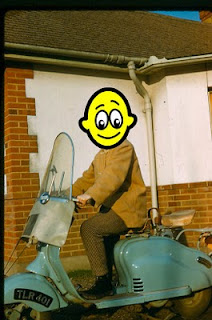 ads to do, BUT, 'Finally' I get to weld the floor pan in.
ads to do, BUT, 'Finally' I get to weld the floor pan in.It was a lovely sunny Sunday - and I was up early to make the most of it. Trouble is I was going to have to do some grinding - I went round to the neighbours to apologise in advance figuring that it would be harder for them to say 'no' that way.
Despite having (wanting!) to go out at lunch time to see eldest daughter perform a 'homeless project' I had the whole of this day to myself - and seeing as England were going to be playing Germany in the World cup (second round?) I was not going to be getting any hassle from anyone wanting me to do anything different.
The leading edge of t
 he floor is butt welded to the trimmed leg shield, and the rear end is welded the lip of the bulk head and side panels. In between it should be a simple case of welding in those drilled out spot weld holes to join the new floor to the existing spine box section. Who said "simple"? There are over 30 of those holes and everyone was a pain in the ass. It was a real challenge to get a good weld in these. Firstly, to get a good wet pool in the base of teh hole (on the new floor metal) you have to either get a lot of power in there or spend a lot of time in there - it seemed very difficult to get this right (as if the arc didnt like it in an enclosed space) and I tried everything from 30 Amps up to 60 Amps. All this has to be balanced against minimising distortion, and minimising burning the hole out.
he floor is butt welded to the trimmed leg shield, and the rear end is welded the lip of the bulk head and side panels. In between it should be a simple case of welding in those drilled out spot weld holes to join the new floor to the existing spine box section. Who said "simple"? There are over 30 of those holes and everyone was a pain in the ass. It was a real challenge to get a good weld in these. Firstly, to get a good wet pool in the base of teh hole (on the new floor metal) you have to either get a lot of power in there or spend a lot of time in there - it seemed very difficult to get this right (as if the arc didnt like it in an enclosed space) and I tried everything from 30 Amps up to 60 Amps. All this has to be balanced against minimising distortion, and minimising burning the hole out. In the end I think I got the hang of it (but not until I had walked away from it for a while in frustration). The weld I believe is strong - penetration evident on the underside of the floor - but it is not pretty - even after grinding off its still pretty ugly. I can live with it..... I'll have to! Its as solid as a rock now, and I hope the paint will distract the eye. If worst comes to worst I shall have to put a lot of 'mod-bling' on it to distract viewers from the scooter itself
In the end I think I got the hang of it (but not until I had walked away from it for a while in frustration). The weld I believe is strong - penetration evident on the underside of the floor - but it is not pretty - even after grinding off its still pretty ugly. I can live with it..... I'll have to! Its as solid as a rock now, and I hope the paint will distract the eye. If worst comes to worst I shall have to put a lot of 'mod-bling' on it to distract viewers from the scooter itselfSo thats it. its all welded up (as far as Im going to go anyway) - there is some bashing to be done still, and some final grinding (actually ive spotted a weld that needs doing too) but I reckon its only about another 3 hours and I can get it to the powder-coaters.














































